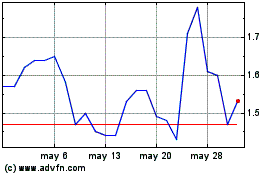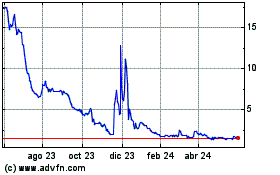- Independent review discusses evidence supporting the use of
betahistine to alleviate residual dizziness following physical
repositioning procedures in benign paroxysmal positional vertigo
(BPPV) patients
- Betahistine is marketed world-wide, except in the US, and
considered standard of care treatment for dizziness / vertigo
- AM-125 is a nasal spray formulation of betahistine currently
being developed by Altamira to overcome low bioavailability of oral
formulation and make treatment option also available to US patients
- Altamira intends to partner or divest AM-125 as part of legacy
assets in strategic pivot to RNA delivery technology
Altamira Therapeutics Ltd. (“Altamira” or the
“Company”) (Nasdaq:CYTO), a company dedicated to developing and
commercializing RNA delivery technology for targets beyond the
liver, today highlighted the publication of an article describing
the rationale for and use of betahistine in the treatment of
residual dizziness following standard of care physical
repositioning procedures for benign paroxysmal positional vertigo
(BPPV). The peer reviewed article was published by an international
group of medical and scientific experts in vestibular disorders in
the journal Frontiers in Neurology1 and reviews the potential
causes of residual dizziness, which has been reported to occur in
31-61% of patients, and available treatment options.
BPPV is characterized by repeated episodes of
vertigo produced by changes in the head position relative to
gravity, e.g. when tipping the head backward. It is typically
caused by dislodged inner ear particles (otoconia) in one of the
semicircular canals, most often the posterior canal. The debris
elicits unwanted vestibular stimulation and is often cleared
through physical repositioning procedures such as the Epley
maneuver, which is strongly recommended by the Clinical Practice
Guideline of the American Academy of Otolaryngology–Head and Neck
Surgery.
BPPV is the most common type of vertigo and
accounts for 17 to 42% of all diagnosed cases; in the United
States, healthcare costs associated with the diagnosis of BPPV
alone approach $2 billion per year. Patients suffering from BPPV
experience significant inconveniences and disabilities during
symptomatic episodes, as they interfere with day-to-day activities
such as driving a car or climbing stairs. Almost 86% of BPPV
patients suffer some interruption to their daily activities and
lost days at work due to BPPV. The dysfunction generally emerges in
the elderly with a peak onset in the 5th and 6th decade.
Even in case of a successful physical
repositioning procedure, patients may experience residual
dizziness. This may last for a few days up to several weeks and may
affect quality of life and be of incapacitating nature. Residual
dizziness may be due to, among others, remaining otoconia,
incomplete vestibular compensation or microcirculation dysfunction.
Based on their review of available treatment options, the authors
of the publication suggest the use of vestibular habituation
therapies and vestibular rehabilitation programs to facilitate
vestibular compensation and treatment with betahistine for
improvement of inner ear blood supply and promotion of vestibular
compensation. An earlier publication by another research group had
already shown in a meta-analysis that the combination of a common
physical repositioning procedure with betahistine treatment
resulted in a significantly greater reduction in dizziness handicap
compared to the procedure alone (p = 0.001).2
“We welcome the additional research into
residual dizziness after physical repositioning procedures in BPPV
since this is a very common and oftentimes serious problem for
patients”, commented Thomas Meyer, PhD, Altamira’s founder,
chairman and CEO. “Treatment of BPPV is the single most important
vestibular indication for betahistine, and we look forward to
testing our AM-125, an intranasal formulation of the drug,
specifically in this condition. AM-125 has a significantly higher
bioavailability than the oral form of betahistine, which is
currently marketed around the world, except for the US. As we are
repositioning the Company around our RNA delivery technology, we
are working towards the partnering of the program with one or
several partners to take it forward and making betahistine
ultimately also available to dizziness patients in the US.”
About Betahistine
Betahistine, a small molecule structural analog
of histamine, acts as an agonist at the H1 histamine receptor and
as an antagonist at the H3 histamine receptor. Unlike histamine, it
crosses the blood-brain-barrier. Betahistine is known to increase
the release of histamine, acetylcholine, dopamine and
norepinephrine in the brain. It increases cochlear, vestibular and
cerebral blood flow and facilitates vestibular compensation and
inhibits neuronal firing in the vestibular nuclei. Betahistine for
oral administration is approved in about 115 countries (with the
U.S. being a notable exception) for the treatment of vertigo and
Meniere’s disease. Despite its good safety profile, the clinical
utility of orally administered Betahistine is limited due to poor
bioavailability.
About AM-125
AM-125 is an intranasal formulation of
betahistine. Because of its ability to circumvent
first-pass-metabolism, AM-125 has been shown to have 5-to-29 times
higher bioavailability than orally administered betahistine.
Altamira Therapeutics is developing AM-125 for the treatment of
acute vestibular syndrome (AVS). The investigational drug has been
tested successfully in a Phase 2 clinical trial (“TRAVERS”) with
patients suffering from AVS following vestibular surgery: compared
to placebo, AM-125 treatment helped accelerate vestibular
compensation and alleviate signs and symptoms of vestibular
dysfunction.3
About Altamira Therapeutics
Altamira Therapeutics (Nasdaq: CYTO) is
developing and supplying peptide-based nanoparticle technologies
for efficient RNA delivery to extrahepatic tissues (OligoPhore™ /
SemaPhore™ platforms). The Company currently has two flagship siRNA
programs using its proprietary delivery technology: AM-401 for KRAS
driven cancer and AM-411 for rheumatoid arthritis, both in
preclinical development beyond in vivo proof of concept. The
versatile delivery platform is also suited for mRNA and other RNA
modalities and made available to pharma or biotech companies
through out-licensing. In addition, Altamira holds a 49% stake
(with additional economic rights) in Altamira Medica AG, its
commercial-stage legacy asset Bentrio®, an OTC nasal spray for
allergic rhinitis. Further, the Company is in the process of
partnering / divesting its inner ear legacy assets. Founded in
2003, Altamira is headquartered in Hamilton, Bermuda, with its main
operations in Basel, Switzerland. For more information, visit:
https://altamiratherapeutics.com/
Forward-Looking Statements
This press release may contain statements that
constitute "forward-looking statements" within the meaning of
Section 27A of the Securities Act of 1933, as amended, and Section
21E of the Securities Exchange Act of 1934, as amended.
Forward-looking statements are statements other than historical
facts and may include statements that address future operating,
financial or business performance or Altamira’s strategies or
expectations. In some cases, you can identify these statements by
forward-looking words such as "may", "might", "will", "should",
"expects", "plans", "anticipates", "believes", "estimates",
"predicts", "projects", "potential", "outlook" or "continue", or
the negative of these terms or other comparable terminology.
Forward-looking statements are based on management's current
expectations and beliefs and involve significant risks and
uncertainties that could cause actual results, developments and
business decisions to differ materially from those contemplated by
these statements. These risks and uncertainties include, but are
not limited to, the success of strategic transactions, including
licensing or partnering, with respect to Altamira’s legacy assets,
Altamira’s need for and ability to raise substantial additional
funding to continue the development of its product candidates, the
clinical utility of Altamira’s product candidates, the timing or
likelihood of regulatory filings and approvals, Altamira’s
intellectual property position and Altamira’s financial position,
including the impact of any future acquisitions, dispositions,
partnerships, license transactions or changes to Altamira’s capital
structure, including future securities offerings. These risks and
uncertainties also include, but are not limited to, those described
under the caption "Risk Factors" in Altamira’s Annual Report on
Form 20-F for the year ended December 31, 2023, and in Altamira’s
other filings with the Securities Exchange Commission (“SEC”),
which are available free of charge on the SEC’s website at:
www.sec.gov. Should one or more of these risks or uncertainties
materialize, or should underlying assumptions prove incorrect,
actual results may vary materially from those indicated. All
forward-looking statements and all subsequent written and oral
forward-looking statements attributable to Altamira or to persons
acting on behalf of Altamira are expressly qualified in their
entirety by reference to these risks and uncertainties. You should
not place undue reliance on forward-looking statements.
Forward-looking statements speak only as of the date they are made,
and Altamira does not undertake any obligation to update them in
light of new information, future developments or otherwise, except
as may be required under applicable law.
Investor Contact: Hear@altamiratherapeutics.com
1 Özgirgin et al. (2024), Residual dizziness after BPPV
management: exploring pathophysiology and treatment beyond canalith
repositioning maneuvers, Front Neurol 15:1382196.
https://www.frontiersin.org/journals/neurology/articles/10.3389/fneur.2024.1382196/full
2 Li et al. (2023), Efficacy of Epley’s maneuver plus
betahistine in the management of PC-BPPV - A systematic review and
meta-analysis, Medicine (Baltimore) 102(13):e33421.
https://journals.lww.com/md-journal/Fulltext/2023/03310/Efficacy_of_Epley_s_maneuver_plus_betahistine_in.34.aspx
3 Van de Heyning et al. (2023), Efficacy and safety of
intranasal betahistine in the treatment of surgery-induced acute
vestibular syndrome: a double-blind, randomized, placebo-controlled
phase 2 study, Otol Neurotol 44(5):493-501.
https://www.ncbi.nlm.nih.gov/pmc/articles/PMC10184813/
Altamira Therapeutics (NASDAQ:CYTO)
Gráfica de Acción Histórica
De Dic 2024 a Ene 2025

Altamira Therapeutics (NASDAQ:CYTO)
Gráfica de Acción Histórica
De Ene 2024 a Ene 2025
